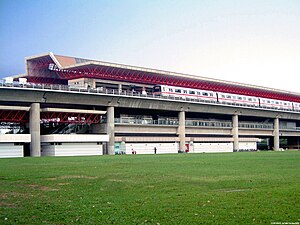

Some MRT stations, particularly interchange stations, are deep enough to be shielded from conventional bomb attacks from the air and act as bomb shelters. This status is enhanced by the fact that underground MRT systems have prebuilt ventilation systems with air-conditioning to ensure a degree of comfort in the unlikely event of a conventional air assault. [1]
Most stations have island platforms, although a few possess side platforms. This is because island platforms are seen to be less costly than side platforms, or possibly to make it convenient for passengers to transfer to another train on the same line but running in the opposite direction. Also, all stations are made to be as straight as possible because the degree that trains would turn at when approaching and leaving a station would be too great if curved stations were built. [2]
Otis was awarded to supply elevators and escalators for the MRT project in 1984, which includes 42 freight elevators and 236 escalators. These elevators are only used for MRT staff to bring fare collection trolleys to the money train. Elevators were off-limits to all commuters and there was no technology used for wheelchair-accessibility. A few surviving elevators of these kind were found at Orchard, Somerset, Simei, Tampines, Pasir Ris, Bedok, Kembangan, and Eunos. Planning for the elevators that are accessible to the public began in 1995, and the process involves doing away freight elevators. Public elevators were introduced at Expo MRT Station in the year 2000, and upgraded to all MRT stations by 2005.
SPH Media Trust's The New Paper is distributed at most stations every weekday morning and Saturdays. [3] Wireless@SG is also deployed at many of the stations including some in the North East, Circle, and Downtown lines. [4] Buskers were deployed to various crowded MRT stations in order to ease overcrowding on the MRT, which has been started at City Hall and Raffles Place during the mornings. [5] Escalator announcements were also put up in Simei and Tanjong Pagar, and charging points were put up at City Hall and Kent Ridge. [6]
Passenger Information Systems
Initially, the MRT system used green electronic displays on the North-South Line and East-West Line from 7 November 1987 until September 2001. They were progressively replaced from 1 July 2001 to September 2001 into plasma displays which is easier for elderly and wheelchair passengers.
Television screens that were displayed in North South and East West lines were only turned on between 5.00am and 1.00am with the exception of train service extension on New Year's Eve all the way until 2.15am. When the station is closed for the day, television screens will be switched off and are unable to show any service information.
References
- ^ "What you need to know about MRT stations". Archived from the original on 26 January 2018. Retrieved 26 January 2018.
- ^ "Narrower gaps between platforms and trains". The Straits Times. 10 February 1999.
- ^ Tan, Angela. "SPH to merge My Paper and TNP, to cut up to 10% staff in right-sizing exercise". The Business Times. Archived from the original on 10 May 2017. Retrieved 21 June 2017.
- ^ Free WiFi at all MRT & LRT stations by 2020
- ^ A Better Commute over the Downtown Line Archived 29 March 2014 at the Wayback Machine
- ^ "SMRT announces new initiatives to enhance commuter experience". Archived from the original on 26 January 2018. Retrieved 26 January 2018.